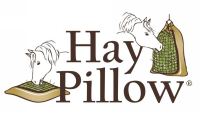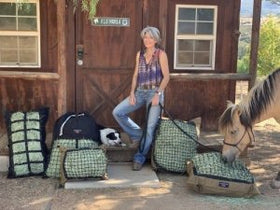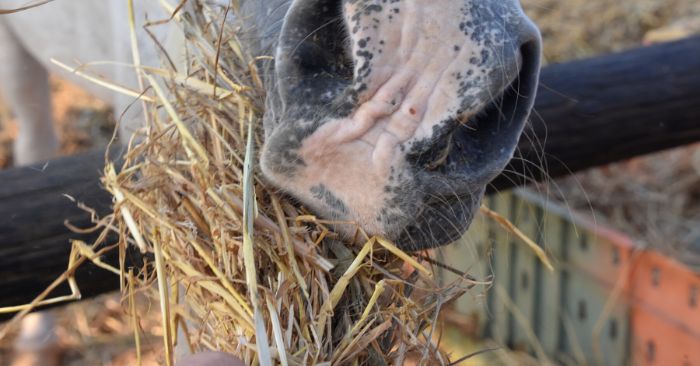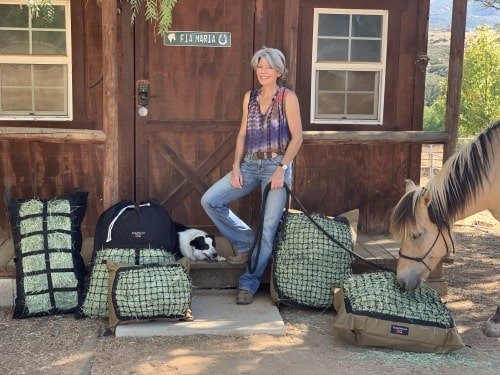A Safer Always Have Hay Source – Mature Grass Hay

Meals vs Free Choice/Always Have Forage
Chew time is critical mentally and physically for grazing herbivores. Horses, donkeys, mules and their miniature counterparts produce gastric acid 24/7 in preparation for constant food uptake. Why? Physically and mentally they are designed to have access to forage 24/7. Chewing activates saliva production (an alkaline substance), which buffers the gastric acid. In addition, the digestive tract depends on a steady flow of fiber to maintain a healthy microbial population and promote gut motility. It's a perfect balance if we follow nature's design.
Slow feeding allows us to both slow consumption – and ensure an always have hay source to extend chew time.
4 Reasons Mature Grass Hay is a Safer Option
- It is the least palatable due to higher neutral detergent fiber (NDF) values, therefore naturally slowing the rate of consumption.
- Has the lowest propensity for storing sugar and starch (2nd to environmental conditions).
- You can visually identify the maturity of a cutting.
- The increased fiber requires longer chew time, naturally slowing the rate of consumption.
Did You Know?
Grass hay straw is a crop cut after seed heads have been harvested. Grass hay farmers routinely harvest seed heads for future plantings and subsequently cut the remainder of the crop selling it as grass hay. It's rarely labeled straw.
NDF% and the Palatability Factor
Tip: You can use higher NDF hays to your advantage if you want to add bulk and chew time to your horse’s diet! Just be sure to offer the additional fiber in an appropriate slow feeder to slow consumption, along with available water, salt and a healthy dental profile for optimum mastication.
Learn more about the palatability factor: Can Horses Eat More Hay Without Weight Gain? The Surprising Factors
What About NSC?
- Environmental conditions
- Maturity
Testing Hay – What You'll Learn
- Accurately determine the percentage of NSC present in your hay. Note: It’s impossible to visually identify accurate levels of NSCs, regardless of the cutting or type of hay. Learn how to test your hay, where to send the sample and how to calculate NSCs using the results.
- Identify the amounts of protein, major and macro mineral content, nitrate levels, ADF%, NDF% and more. This information allows you to accurately balance the diet with proper levels and ratios of nutrients that are missing in the hay. Dr. Eleanor M. Kellon, VMD offers comprehensive courses online to learn how to formulate a custom vitamin mineral mix to balance your horse’s diet according to your hay test results.
When You Cannot Test – Focus on Maturity
Although feeding untested hay is always a risk, the safest option is to offer slow fed* higher NDF (mature) hay with empty seed heads or grass hay straw (mature grass hay with the seed heads harvested) in addition to a limited amount of lower NDF (immature) hay. Your horse will eat the more palatable, lower NDF hay first and have his slow-fed higher NDF available to nibble on the rest of the time. The free choice forage benefits can prevent an array of adverse mental and physical conditions such as colic, ulcers, and stereotypies to name a few.
Note: The NDF value (percentage) increases with maturity. A simple comparison could be; 20 lbs. of a lower NDF (immature) hay may equate - in digestible energy, protein, nutrients, sugar/starch content and calories - to 30 lbs. of higher NDF (mature) hay. You are feeding more to extend chew time with the goal of achieving slow fed free choice forage.
If you board your horse, it may be worthwhile to buy your own supplemental slow fed,* always have hay source (higher NDF/mature) and have them feed limited amounts of the hay included in your monthly fee.
* We define slow fed as the smallest mesh size the individual can extract hay from without frustration. See Choosing A Mesh Size for more tips.
Cutting Verses Maturity
How to Identify Maturity
- Immature grass hay cuttings will be shorter and softer with no seed heads and a high leaf to stem ratio. The length is typically 3” – 5”.
- The more mature cuttings will be longer and more course, with a higher stem to leaf ratio, empty seed heads or void of seed heads (straw). The length is typically 9” – 16”.

Quality Verses Maturity
- Offer more palatable hay and feed the least amount of forage to meet the daily caloric requirements in order to maintain body condition and energy requirements - then more immature cuttings (low NDF) would be considered higher quality hay.
- Provide more volume and chew time - then a good quality mature forage (high NDF) is key.
Quality forage, for all intents and purposes, is free of adverse odor, dirt, mold, weeds, trash or other foreign materials with acceptable color.
Using the Palatability Factor to Naturally Slow Consumption
- Less palatable hay should naturally reduce the rate of consumption. When combined with a slow feeder, which prevents them from picking through it, you’ve got a win/win situation!
- Cool season grasses - such as orchard grass, timothy and rye (having the highest propensity of all grass hays to be high in NSC’s) - tend to be more palatable than warm season grasses (such as bermuda, teff and tifton hays).
- Feeding a combination of warm and cool season grasses can be beneficial by providing a more diverse amino acid profile.
- My preference is a slow fed mature warm season grass hay as an always have hay source and a slow fed cool season grass hay in limited amounts. Both my orchard grass and bermuda hays are tested with confirmed NSC levels well below 10% and averaged 64% NDF. My horses have consistently preferred orchard grass over bermuda despite the maturity of the cutting.
- If you feed more than one type of hay, feed them separately. Blending less palatable hay with more palatable hay will defeat the natural influence of the palatability factor.
- Learn how to introduce new forages gradually, step by step.
Additional Tips
Implement Slow Feeders
Using slow feeders or bale nets promotes increased chew time and further reduction of particle size. Chewing activates saliva production providing moisture (higher saliva to forage ratio) and aids in digestion. The faster they eat, the quicker the stomach empties. Once the stomach becomes two-thirds full, it begins to empty regardless of how well the particles are prepared to advance to the small intestine. Gastric acid aids in the breakdown of feed particles combined with the enzyme pepsin initiating protein digestion in the stomach. This better prepares fiber content for optimal digestion as it travels through the remainder of the digestive tract.
Perform Routine Dental Exams to Avoid Colic
Include exams for all ages to check for retained caps, lost and/or broken teeth, abnormal or uneven bite planes, infected teeth and/or gums, periodontal disease and hooks - which are sharp protrusions of teeth that can penetrate the opposing gum.
High NDF forage requires optimum mastication (grinding), which depends upon unobstructed motion of the jaw. Any condition causing pain can discourage the required chew time necessary for proper digestion - and may induce colic and/or choke.
Feed From Ground Level
A natural grazing position allows the mandible (jaw bone) to come down and forward in the atlantoaxial and temporomandibular joints. This enables the mandible to move freely up and down, side to side, forward and back without any restriction. This free movement facilitates natural wear of teeth along with optimum mastication and reduction of particle size.
Supplement for Balance
Unlike their domestic counterparts, horses in the wild have a wide variety of forages to choose from. They self balance naturally. Every hay-only diet requires supplementation. No hay is ever balanced to itself (optimum ratios), nor will it contain the National Research Council (NRC) minimum requirements of all vitamins and minerals. If you don’t test and balance your hay, feed at least the minimum requirements of salt, a healthy source of omegas and a comprehensive concentrated vitamin mineral supplement to promote optimum immune, hormone, neurological and thyroid function.
Concluding Thoughts
- While it is common knowledge that free-choice forage is optimum for all grazing herbivores mentally and physically - finding solutions within domestic environments can be challenging.
- Consult your veterinarian prior to making dietary changes.
- Research is lacking to accurately determine the bio availability of nutrients comparing low NDF hay to high NDF hay in horses.
- Always introduce any new feedstuff gradually.
- Offering a natural lifestyle, routine exercise and an appropriate diet promotes a happier, healthier herd and can relieve your stress levels as well!
Helpful How to Resources
- Can Horses Eat More Hay Without Weight Gain? The Surprising Factors
- Sand Colic - The Surprising (Simple) Cure & Prevention
- How & Where to Test Your Horse's Hay & Interpret Results
- Sugar Content of Pasture & Hay: Q & A with Katy Watts, Founder of Safergrass.org
- 9 Benefits of Slow Feeding Horses
- 7 Slow Feed Dos and Dont's for Horses
- How to Introduce & Incorporate Free-Choice Forage: A Detailed Action Plan
- Slow Feed Solutions for Any Environment
- Feeding Miniature Horses & Donkeys: Why Slow Fed Forage is Best
- Feeding Free Choice - How I Chose the Best Slow Feeder
- 7 Easy Ways to Help Prevent Colic
- Preventing Equine Gastric Ulcers - How Forage Buffers Acid
- Causes of Equine Ulcers – 7 Stress Factors & Solutions
- Never Exercise Horses on an Empty Stomach...Ever
- Why You Shouldn't Transport Horses On An Empty Stomach
- Why Most Horses Prefer to Eat Outside
References
- KPP staff. Picking Hay for Sugar/Starch Sensitive Horses. Retrieved from https://kppusa.com/picking-hay-sugarstarch-sensitive-horses/
- Hoffman P.C., Lundberg K.M., Bauman L.M. and Shaver R. D. The Effect of Maturity on NDF Digestibility. Retrieved from https://fyi.extension.wisc.edu/forage/the-effect-of-maturity-on-ndf-digestibility/
- Kellon, E., VMD. (2017, September 3) What Can You Tell By Just Looking at Hay? Retrieved from https://drkhorsesense.wordpress.com/2020/11/05/can-you-tell-good-hay-by-looking-at-it/
- Watts, K. Factors affecting NSC Levels In Grass. Retrieved from: https://static1.squarespace.com/static/5e7fddf934de306c2b8cc313/t/5e862934474ea011f25fe41c/1585850676230/factorseffectingNSC.pdf







